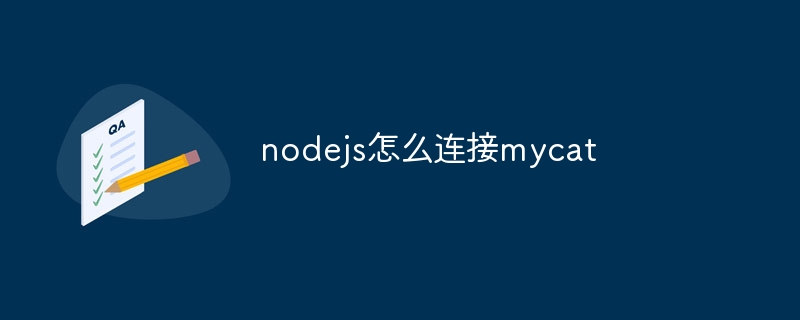Steps to connect MyCAT in Node.js: Install the mycat-ts dependency. Create a connection pool, specify the host, port, username, password and database. Use the query method to execute SQL queries. Use the close method to close the connection pool.

How to connect to MyCAT in Node.js
MyCAT is a distributed database middleware for connecting different databases. By using Node.js, you can easily connect to and interact with MyCAT.
Installing dependencies
First, install mycat-ts dependencies in the project:
<code>npm install mycat-ts</code>
Connect MyCAT
Use mycat-ts Create a connection pool:
import { Pool } from "mycat-ts";
const pool = new Pool({
host: "mycat_host",
port: 8066,
user: "mycat_user",
password: "mycat_password",
database: "mycat_database",
});Note:
hostis the host address of MyCAT.portis the port of MyCAT, the default is 8066.userandpasswordare the username and password used to connect to MyCAT.databaseis the MyCAT database to be connected.
Query data
After obtaining the connection, you can use the query method to execute the SQL query:
const results = await pool.query("SELECT * FROM table_name");Close the connection pool
Use the close method to close the connection pool:
await pool.close();
Example
The following is a complete Example showing how to connect to MyCAT and query data:
import { Pool } from "mycat-ts";
async function main() {
const pool = new Pool({
host: "mycat_host",
port: 8066,
user: "mycat_user",
password: "mycat_password",
database: "mycat_database",
});
const results = await pool.query("SELECT * FROM table_name");
console.log(results);
await pool.close();
}
main().catch(console.error);The above is the detailed content of How to connect nodejs to mycat. For more information, please follow other related articles on the PHP Chinese website!

Hot AI Tools

Undress AI Tool
Undress images for free

Undresser.AI Undress
AI-powered app for creating realistic nude photos

AI Clothes Remover
Online AI tool for removing clothes from photos.

Clothoff.io
AI clothes remover

Video Face Swap
Swap faces in any video effortlessly with our completely free AI face swap tool!

Hot Article

Hot Tools

Notepad++7.3.1
Easy-to-use and free code editor

SublimeText3 Chinese version
Chinese version, very easy to use

Zend Studio 13.0.1
Powerful PHP integrated development environment

Dreamweaver CS6
Visual web development tools

SublimeText3 Mac version
God-level code editing software (SublimeText3)
 What is the difference between npm and npm.cmd files in the nodejs installation directory?
Apr 21, 2024 am 05:18 AM
What is the difference between npm and npm.cmd files in the nodejs installation directory?
Apr 21, 2024 am 05:18 AM
There are two npm-related files in the Node.js installation directory: npm and npm.cmd. The differences are as follows: different extensions: npm is an executable file, and npm.cmd is a command window shortcut. Windows users: npm.cmd can be used from the command prompt, npm can only be run from the command line. Compatibility: npm.cmd is specific to Windows systems, npm is available cross-platform. Usage recommendations: Windows users use npm.cmd, other operating systems use npm.
 Is nodejs a backend framework?
Apr 21, 2024 am 05:09 AM
Is nodejs a backend framework?
Apr 21, 2024 am 05:09 AM
Node.js can be used as a backend framework as it offers features such as high performance, scalability, cross-platform support, rich ecosystem, and ease of development.
 Can nodejs write front-end?
Apr 21, 2024 am 05:00 AM
Can nodejs write front-end?
Apr 21, 2024 am 05:00 AM
Yes, Node.js can be used for front-end development, and key advantages include high performance, rich ecosystem, and cross-platform compatibility. Considerations to consider are learning curve, tool support, and small community size.
 What are the global variables in nodejs
Apr 21, 2024 am 04:54 AM
What are the global variables in nodejs
Apr 21, 2024 am 04:54 AM
The following global variables exist in Node.js: Global object: global Core module: process, console, require Runtime environment variables: __dirname, __filename, __line, __column Constants: undefined, null, NaN, Infinity, -Infinity
 Is nodejs a back-end development language?
Apr 21, 2024 am 05:09 AM
Is nodejs a back-end development language?
Apr 21, 2024 am 05:09 AM
Yes, Node.js is a backend development language. It is used for back-end development, including handling server-side business logic, managing database connections, and providing APIs.
 How to connect nodejs to mysql database
Apr 21, 2024 am 06:13 AM
How to connect nodejs to mysql database
Apr 21, 2024 am 06:13 AM
To connect to a MySQL database, you need to follow these steps: Install the mysql2 driver. Use mysql2.createConnection() to create a connection object that contains the host address, port, username, password, and database name. Use connection.query() to perform queries. Finally use connection.end() to end the connection.
 What projects is nodejs suitable for?
Apr 21, 2024 am 05:45 AM
What projects is nodejs suitable for?
Apr 21, 2024 am 05:45 AM
Node.js is suitable for the following project types: Network and server applications Event-driven applications Real-time applications Data-intensive applications Command-line tools and scripts Lightweight microservices
 How to deploy nodejs project to server
Apr 21, 2024 am 04:40 AM
How to deploy nodejs project to server
Apr 21, 2024 am 04:40 AM
Server deployment steps for a Node.js project: Prepare the deployment environment: obtain server access, install Node.js, set up a Git repository. Build the application: Use npm run build to generate deployable code and dependencies. Upload code to the server: via Git or File Transfer Protocol. Install dependencies: SSH into the server and use npm install to install application dependencies. Start the application: Use a command such as node index.js to start the application, or use a process manager such as pm2. Configure a reverse proxy (optional): Use a reverse proxy such as Nginx or Apache to route traffic to your application






